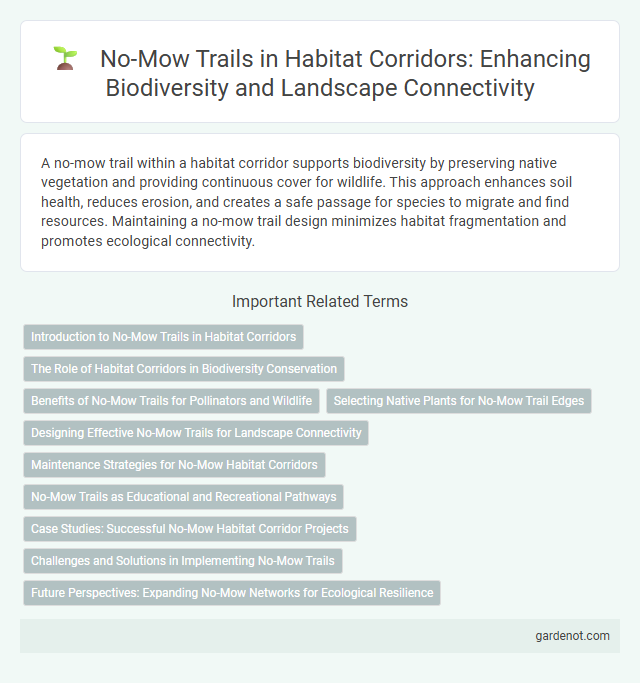A no-mow trail within a habitat corridor supports biodiversity by preserving native vegetation and providing continuous cover for wildlife. This approach enhances soil health, reduces erosion, and creates a safe passage for species to migrate and find resources. Maintaining a no-mow trail design minimizes habitat fragmentation and promotes ecological connectivity.
Introduction to No-Mow Trails in Habitat Corridors
No-Mow Trails in habitat corridors provide essential pathways that enhance biodiversity by preserving native vegetation and minimizing soil disruption. These trails encourage natural regeneration, offering shelter and food sources for wildlife while improving ecosystem connectivity. Implementing No-Mow Trails supports sustainable habitat conservation by reducing maintenance impacts and promoting ecological resilience.
The Role of Habitat Corridors in Biodiversity Conservation
No-mow trails serve as vital habitat corridors that connect fragmented ecosystems, facilitating the movement of wildlife and the dispersal of native plant species. These corridors enhance biodiversity by providing safe passage for pollinators, small mammals, and birds, thereby promoting genetic diversity and ecosystem resilience. Maintaining no-mow trails reduces habitat isolation, helping to counteract the negative effects of urbanization and habitat fragmentation on local flora and fauna.
Benefits of No-Mow Trails for Pollinators and Wildlife
No-mow trails create essential habitat corridors by allowing native plants to flourish, providing food sources and shelter for pollinators like bees, butterflies, and hummingbirds. These trails reduce habitat fragmentation, enhance biodiversity, and support wildlife movement between green spaces. By minimizing mowing, no-mow trails promote healthier ecosystems that sustain pollinator populations critical for plant reproduction and overall ecological balance.
Selecting Native Plants for No-Mow Trail Edges
Selecting native plants for no-mow trail edges enhances habitat corridors by providing essential food and shelter for local wildlife, supporting biodiversity and ecosystem resilience. Native species, adapted to the regional climate and soil, require less maintenance and promote healthier soil structure and water retention. Incorporating a diverse mix of native grasses, wildflowers, and shrubs creates natural buffers that connect fragmented habitats and facilitate wildlife movement.
Designing Effective No-Mow Trails for Landscape Connectivity
Designing effective no-mow trails enhances habitat corridors by maintaining native vegetation that supports wildlife movement and biodiversity. These trails reduce soil compaction and preserve natural microhabitats, facilitating connectivity between fragmented landscapes. Strategic placement along migration routes or linking isolated green spaces maximizes ecological benefits and promotes seamless habitat integration.
Maintenance Strategies for No-Mow Habitat Corridors
Maintenance strategies for no-mow habitat corridors emphasize minimal intervention to preserve native plant diversity and soil health. Regular monitoring of invasive species and selective removal ensures the integrity of the ecosystem while promoting wildlife movement. Adaptive management practices, such as seasonal mowing or targeted herbicide application, support long-term sustainability and habitat connectivity.
No-Mow Trails as Educational and Recreational Pathways
No-Mow Trails serve as vital habitat corridors promoting biodiversity by allowing native plants to flourish while providing accessible educational and recreational pathways for communities. These trails enhance environmental awareness by demonstrating the importance of native vegetation in supporting pollinators and wildlife habitats, creating immersive outdoor classrooms. Integrating No-Mow Trails into urban planning fosters sustainable green spaces that balance ecological health with public engagement.
Case Studies: Successful No-Mow Habitat Corridor Projects
No-mow trail projects like the Roxbury Habitat Corridor in New York demonstrate significant ecological benefits by enhancing biodiversity and facilitating wildlife movement. Case studies reveal that these corridors support native pollinators, small mammals, and bird species by providing continuous habitat amidst urban landscapes. Effective management practices include minimal disturbance, native plant restoration, and community engagement to maintain ecological connectivity.
Challenges and Solutions in Implementing No-Mow Trails
Implementing no-mow trails in habitat corridors presents challenges such as invasive species encroachment and public resistance to unmanicured landscapes. Effective solutions include targeted invasive species management and community engagement initiatives to raise awareness of ecological benefits. Utilizing adaptive maintenance schedules that balance trail accessibility with habitat preservation enhances long-term success of no-mow corridors.
Future Perspectives: Expanding No-Mow Networks for Ecological Resilience
Expanding no-mow trail networks enhances habitat corridors by promoting native biodiversity and supporting wildlife movement across fragmented landscapes. Increasing connectivity through strategic no-mow areas improves ecological resilience against climate change and urbanization impacts. Integrating these trails into regional conservation plans fosters sustainable environments and long-term ecosystem stability.
No-mow trail Infographic

 gardenot.com
gardenot.com